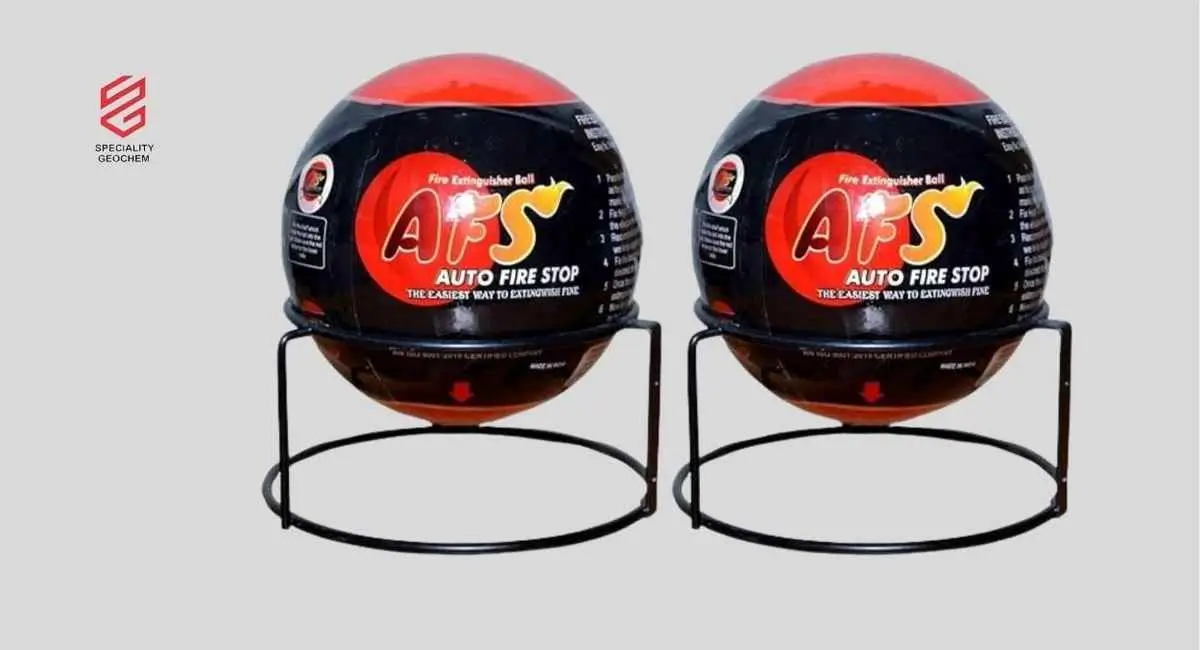Types of Fire Extinguisher Ball: Fire safety is no longer a luxury—it’s a necessity. Whether at home, or within industrial settings, having quick access to a fire-fighting solution can be the difference between a minor incident and a catastrophe. One such modern innovation is the Fire Extinguisher Ball, a self-activating fire suppression device that is simple, lightweight, and extremely effective.
In this blog, we will explore the Types of Fire Extinguisher Balls, how they work, and which one is best suited for your needs.
What is a Fire Extinguisher Ball?
Before diving into types, let’s understand the basics. A fire extinguisher ball is a round-shaped safety device that contains a dry chemical agent, typically monoammonium phosphate, designed to suppress fires upon activation. When thrown into or placed in fire-prone areas, it bursts upon contact with flames—releasing the chemical to douse the fire effectively in seconds. It’s compact, maintenance-free, and often activates within 3 to 5 seconds of detecting flames.
Why Choose a Fire Extinguisher Ball Over Traditional Extinguishers?
Advantages of Fire Extinguisher Balls:
- No training needed – anyone can use it.
- Self-activating – works even if no one is present.
- Low maintenance – typically 5-year shelf life with no refilling required.
- Lightweight and portable – ideal for small and large spaces.
Types of Fire Extinguisher Balls
Not all fire extinguisher balls are made the same. Various types are available in the market, distinguished by their intended use, chemical composition, and structural design. Let’s explore them in detail:
1. Manual Activation Fire Extinguisher Balls
These are designed to be thrown manually into the fire. Once they come in contact with flames, they explode and release the fire suppressant.
- Use case: Home kitchens, vehicles, electrical boxes.
- Best for: Small fires where someone is present to throw the ball.
2. Auto-Activation Fire Extinguisher Balls
These balls are mounted in high-risk areas and designed to automatically activate when fire or heat is detected.
- Use case: Server rooms, factories, warehouses.
- Best for: Areas where humans may not be present during the fire outbreak.
3. ABC Dry Powder Fire Extinguisher Balls
ABC fire extinguisher balls use monoammonium phosphate as their agent, making them suitable for tackling Class A fires (common combustibles), Class B fires (flammable liquids), and Class C fires (electrical sources).
- Use case: Multi-environment applications (homes, offices, shops).
- Best for: Users who need coverage across various fire classes.
4. AFS (Auto Fire Stop) Fire Extinguisher Balls
AFS is a well-known brand offering fire balls that automatically suppress fires using dry powder. These are highly reliable and certified for fire safety standards.
- Use case: Homes, schools, and small businesses.
- Best for: General-purpose use with high safety assurance.
5. Environmentally Friendly Fire Extinguisher Balls
These are non-toxic, biodegradable versions of the fire extinguisher ball made for environments where chemical exposure needs to be minimized.
- Use case: Food industries, eco-sensitive zones, children’s rooms.
- Best for: Eco-conscious users looking for safety without chemical risks.
7. Industrial-Grade Fire Extinguisher Balls
These are larger and more potent versions of fire balls with enhanced chemical capacity and range. They may have multiple activation features and broader suppression zones.
- Use case: Large manufacturing units, oil storage areas, chemical plants.
- Best for: High-risk industrial zones requiring fast and wide-scale response.
Choosing the Right Type of Fire Extinguisher Ball
Factors to Consider:
- Location of use: Indoor vs. outdoor, vehicle, industrial.
- Fire Class: Make sure the extinguisher is suitable for the likely fire type.
- Activation Mode: Manual or automatic based on user proximity.
- Size and Capacity: Larger areas may need multiple or industrial-sized balls.
- Certification: Look for safety compliance (CE, ISO, etc.)
How to Install or Use a Fire Extinguisher Ball
- For auto models: Mount them in areas of high risk such as near circuit boxes, kitchens, or engines using a wire cradle or bracket.
- For manual use: Place them in an accessible location. In case of fire, throw the ball directly into the flames.
- Keep out of children’s reach unless specifically meant for child-safe zones.
Fire Extinguisher Balls vs Traditional Extinguishers
| Feature | Fire Extinguisher Ball | Traditional Extinguisher |
| Operation | Automatic / Manual Throw | Manual (pin, nozzle, squeeze) |
| Maintenance | No maintenance required | Requires regular checks |
| Activation Time | 3-5 seconds after fire contact | Depends on human reaction |
| Cost | Economical in the long term | May need refilling / inspection |
| Portability | Lightweight and easy to install | Bulky in some cases |
Conclusion : Types of Fire Extinguisher Ball
Understanding the Types of Fire Extinguisher Balls helps in making the right decision for your fire safety needs. Whether it’s for your home, office, or factory, these compact and efficient devices provide peace of mind, ease of use, and immediate action when it matters most. Investing in the right fire extinguisher ball is a smart step toward proactive fire prevention.
At Speciality Geochem, we emphasize the importance of choosing the correct type based on the environment and fire classification. Making an informed decision means you’re not only protecting property—but also saving lives. Take a proactive approach to fire safety with the right fire extinguisher ball that delivers confidence, convenience, and peace of mind.
FAQs : Types of Fire Extinguisher Ball
1. Are fire extinguisher balls reusable?
No, fire extinguisher balls are single-use devices. Once activated, they must be replaced.
2. Can fire extinguisher balls be used on electrical fires?
Yes, most models—especially ABC dry powder balls—are safe for Class C (electrical) fires.
3. How long do fire extinguisher balls last?
The average lifespan of a fire extinguisher ball is around 5 years, though this can vary based on the manufacturer and how well it is stored.
4. Are fire extinguisher balls safe to use in homes with kids?
Yes, but make sure to place them out of children’s reach unless designed specifically for child-safe areas.
5. Where should I install a fire extinguisher ball?
Install the fire extinguisher ball in high-risk zones such as kitchens, electrical switchboards, vehicles, or storage areas where fires are more likely to occur. For automatic balls, mount them using the provided bracket.

